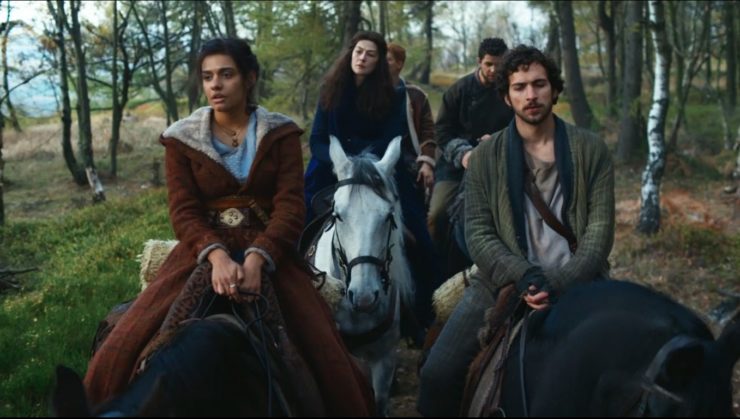It’s time for episode two of The Wheel of Time, in which Egwene learns more about how the Aes Sedai work, and everyone has some disturbing dreams.
(This review contains spoilers for “Shadow’s Waiting,” the second episode of The Wheel of Time TV series. It may also contain some references to Robert Jordan’s Wheel of Time novels, but will try to avoid important plot spoilers. Please note that the comment section may also contain spoilers for those unfamiliar with the book series.)
Recap
“Shadow’s Waiting” opens on a Whitecloak encampment. Eamon Valda (Abdul Salis) taunts an Aes Sedai, whose hands he has cut off. He takes her ring and burns her at the stake while enjoying a meal.
Lan, Moiraine, Rand, Perrin, Egwene, and Mat flee on horseback as evening falls, pursued by Trollocs. They cross the river on a ferry while the Trollocs stop, afraid to cross deep water. The four villagers are horrified when Moiraine destroys the ferry so that the Trollocs cannot use it to cross after them, and the ferryman dies trying to stop it.
Buy the Book
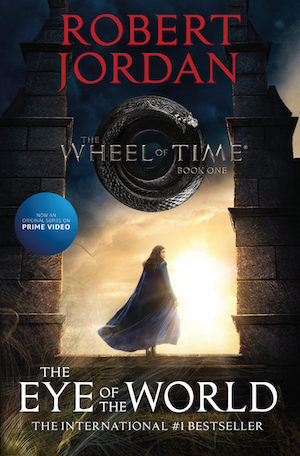

The Eye of the World: Book One of The Wheel of Time
Later, while camping, Moiraine uses her Power to help the tired horses, and Egwene and the boys wonder how much they can trust her. While everyone sleeps, Moiraine explains the Three Oaths of the Aes Sedai to Egwene and shows Egwene that she, too, can touch the True Source. Perrin is hiding an injury from the battle against the Trollocs. Rand dreams of coughing up a bat, and of a figure with fiery eyes, only to wake and find a real dead bat on the ground and Mat, Perrin, and Egwene having had similar dreams. Rand fights with Moiraine, but his friends point out they’re better off with her than without.
They encounter Eamon Valda and a group of Whitecloaks. Lan hides Moiraine’s ring and they pass themselves off as travelers from Taren Ferry. Afterward, Moiraine explains to Egwene that everything she told the Whitecloaks was true, just not the truth it sounded like. Later while camping, Perrin has an encounter with a pack of wolves, one of which licks his wound before running off.
That night, a Fade and Trollocs find them. Moiraine is too weak and sick to wake, so Lan leads the group towards the fallen city of Shadar Logoth. The horses balk at entering the walls, but once the group gets inside, the Trollocs won’t follow them. Lan warns them not to touch anything. Mat tells Perrin that Laila’s death wasn’t his fault and gives him a dagger that she forged.
Later, while exploring, Mat finds a chest with a jeweled dagger inside. Suddenly dark tendrils begin weaving through the village, turning one horse into crumbling stone and scaring off some of the others. The quartet is separated by one of the tendrils, with Mat and Rand forced to run one way, and Perrin and Egwene the other. To escape the dark tendrils, both groups are forced to jump into the river at different points, unable to find each other.
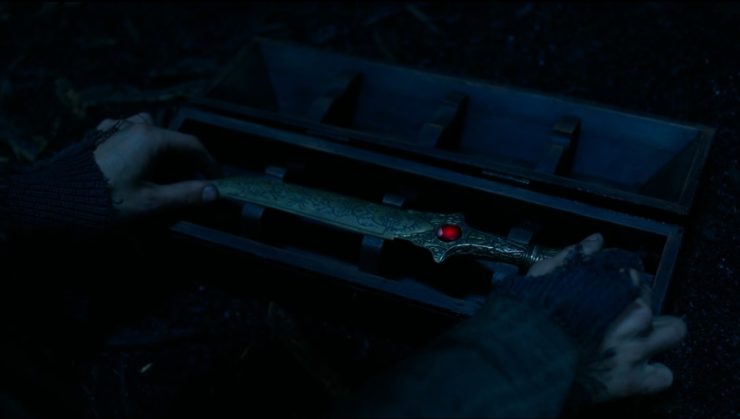
Moiraine wakes, realizes where they are, and tells Lan that he has killed them all. Nevertheless, they escape with their horses, out the same way they entered. Lan lays Moiraine on the ground and tries to get her to drink water, when suddenly there is a blade at his throat. He looks up at Nynaeve, who declares:
“If you don’t take them to me right now, I’ll slit your throat.”
Analysis
This is one of the most exciting endings to an episode of television I have ever seen. Granted, I am a little biased because Nynaeve is my favorite character from the books, and I’m really excited to see the development of her character and relationships in the show. But I think even in the context of what we’ve seen of her on screen, the show has already shown us a lot about who she is, and the reveal that she is not only still alive, but has somehow tracked the group all the way here, is pretty fantastic.
I must say that I think our introduction to Nynaeve might even be better than our introduction to Egwene. Nynaeve’s confrontation with Moiraine in the pool shows us that she is both stubborn and determined (definitely traits one would need to escape being eaten by Trollocs and to track an Aes Sedai through open country), and also that she has a very distinctive blend of pride and humility in her. It will be really interesting to see her interact with Moiraine and Lan going forward.
As does Mat—I loved that he was reminiscing about Nynaeve by thinking of how she’d be haranguing Moiraine if she was with them. Bit of foreshadowing there, too, I expect.
Our introduction to the Whitecloaks, aka the Children of the Light, is highly effective as well, and also quite chilling. The show has upped the ante a little here—it’s fairly understood that the Whitecloaks hate the Aes Sedai, and that a good number of them would like to kill an Aes Sedai if they could manage it without being caught. But the blatancy of Valda wearing the rings as trophies is something that caught me by surprise, as did the way the show makes literal the concept of the Aes Sedai being treated like witches, going so far as to show one being burned at the stake.
We’re getting a bit more of a sense of the world, and the Aes Sedai’s place in it. We have been shown that the Aes Sedai have great power (little P in this case) and status. But they also have enemies like the Whitecloaks—people who claim to be on the side of the Light and yet would murder an Aes Sedai in cold blood. Since we’re watching Moiraine literally fight to save the world from the Dark, that tells you a lot about this organization.
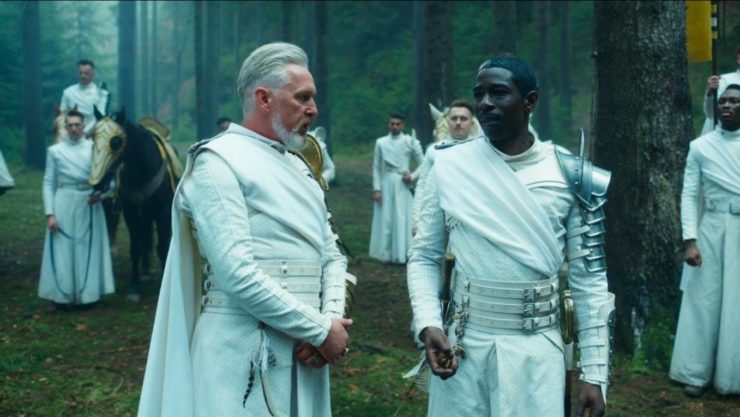
The Whitecloaks costuming is really evocative here, too. I loved the way the wide trousers resemble robes, evoking the idea of a religious order, and the way the sunburst symbol (described in the book as a badge worn on their breasts) is worked into the top of their pauldrons. I also think it’s striking to see the discontinuity between the attitude of the military commander Geofram Bornhald, who was not suspicious of the travelers and even went so far as to advise Moiraine to find an Aes Sedai to help her, and Valda, the Questioner who interrogated and manhandled her… and who would have killed her if he found out who she really is. From this interaction, as well as the conversation Bornhald and Valda had afterwards, you get the sense that Bornhald is the leader and “in charge” but that Valda holds much of the actual power. Given what we’ve seen of that guy, it’s a troubling revelation.
In the novels, the idea that the truth an Aes Sedai speaks is not necessarily the truth you think you hear is an accusation that is often leveled at members of the White Tower. I really like how in the show it is instead a lesson Moiraine is teaching Egwene, preparing her for interacting with Aes Sedai, and perhaps for becoming one herself one day. Rather than focusing on the point of view of those who feel they need to be on the defensive against Aes Sedai word trickery, we’re focusing on how these women need to learn very specific, and often challenging, survival skills in order to move about in their world.
The lying-without-lying skill is a really good analogy for the experience of being a woman in general. Even in our modern-day world—where women’s rights and equality have largely improved in comparison to the medieval era from which The Wheel of Time pulls much of its world building—women often find it necessary to soften truths, or tell white lies, in order to stay safe or convince men to listen to them. Women in the office sector report having to soften criticism or suggestions that their male counterparts can offer without caveat. Wives expected to do most of the housework might ask their husbands for “a favor” when they need help, or find that he expects to be thanked or rewarded just for helping to keep his own home in working order. Women being hit on in bars might offer the rejection-softening “I have a boyfriend” rather than honestly say they’re just not interested, fearing a possibly hostile or violent reaction.

Moiraine doesn’t lie when she says she has a sister in Whitebridge—as Obi-Wan would point out, this is perfectly true from a certain point of view. But if she had told a more literal truth about who she was and who that “sister” was, then her life would have been in danger. One is left wondering how often she has had to employ this skill, how often the truth someone else heard was all that stood between her and possible calamity. The woman took a poison dagger to the shoulder, and we’ve watched her struggle with the pain and fatigue that wound brings, but this moment, when she explains to Egwene how she dissembled without lying, is the first moment we’ve felt that she could be vulnerable.
The same theme is present in the earlier scene when Moiraine shows Egwene how to work with the Power. She tells Egwene that her greatest strength is her mind, even more than the Power inside her. This is also the first time that we’ve heard the term “One Power,” which is how the Power is consistently referred to in the books.
Rand’s kind of being a butt in this episode, isn’t he? I mean, I can’t really blame him after all he’s been through. But at the same time, it’s clear that he’s not just feeling distrustful of Moiraine and uncertain about his own future. His scenes with Egwene show us that he is still struggling with the fact that she chose a different path than the one that would make her his wife. Egwene isn’t going to be Wisdom, but Rand has noticed her connection to Moiraine, so the Aes Sedai is the new symbol of what Rand has lost.
I thought it was interesting that Mat was the one being the most practical about their situation with Moiraine. I’m still struggling to let go of my desire for him to be characterized closer to the book version, but putting that aside for a moment, this moment says something different about his personality than what we’ve seen so far. He is clearly a bit reckless with himself and his fortune in episode one—being a gambler, especially if you’re bad at it, isn’t a practical choice to deal with one’s money problems, even if it is an understandable one. (Heck, relatable even.) But Mat shows here that he is capable of assessing a situation for what it is, rather than what he wants it to be. He doesn’t trust Moiraine any more than Rand does, but he can see that she is their best option for the time being, and he is very cognizant that it is important for the four of them to stick together.
Of course, then he stops being practical and starts picking up jeweled daggers in cursed evil ruins right after he was told not to. I guess he figures it was a stroke of good luck, since he just gave away the one he had. That was a touching moment between him and Perrin, anyway.
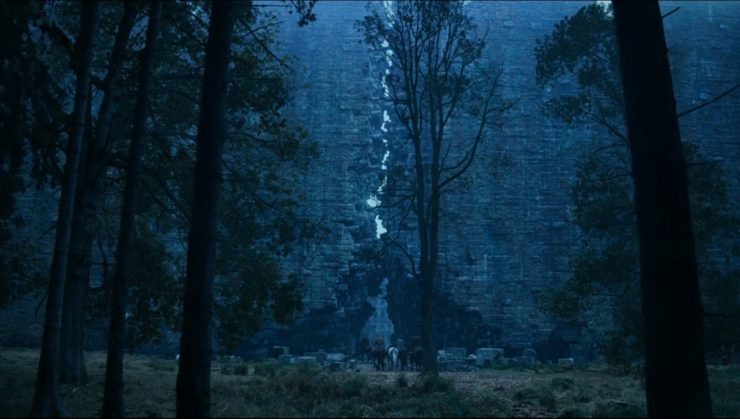
I loved the visuals of Shadar Logoth, from the way the entrance looked almost like a portal, to the arches and carvings of the buildings, to the big hall where Lan brought them all to rest. I might go so far as to say that it’s my favorite set so far. It obviously reminded me of the Mines of Moria, to which both book and show pay homage, but the slim vertical crack in the wall that allows the company to enter it also reminded me of the Paths of the Dead from The Return of the King, which was a nice touch.
Lan’s love and care for Moiraine is obvious in this episode, and we see how keyed in he is to her state of being as he advises her that she needs her strength as much as the horses need theirs. He doesn’t have much dialogue, but the camera often frames him behind one of her shoulders, indicating the way he is there to watch her back, and prop her up if needed. Daniel Henney also strikes the tricky balance of depicting Lan as a very stoic person who keeps his emotions to himself and yet letting us see very clearly—in little gestures, the quirk of his lips, in the tone of his voice—how deeply he cares for Moiraine. And how worried he is about her.
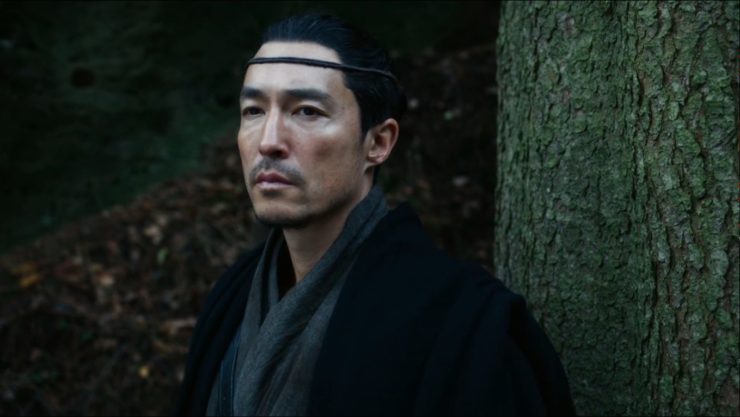
And now she’s fading, and Lan also has a new problem, named Nynaeve al’Meara, to worry about.
Interesting Notes and Easter Eggs:
- “Shadow’s Waiting is the title of Chapter 19 of The Eye of the World
- Of course everyone probably caught the homage to The Lord of the Rings with the ferry scene. I liked the way the visuals mirrored the film a bit more, with the way the Trollocs visibly balked at the edge of the pier, just as the ringwraiths’ horses did.
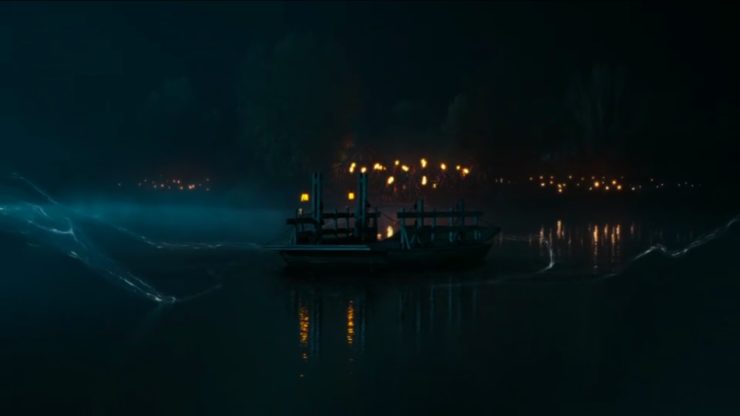
- I loved the “Weep for Manetheren” song. The story of Manetheren and the heritage of the Two Rivers is from the books, but I loved having it as a song that has been passed down by their people. This also reminded me a bit of The Lord of the Rings, or rather, of the dwarves’ Misty Mountain song in The Hobbit. It was almost as beautiful, too.
- That was a really sweet moment with Perrin giving Egwene his cloak while they’re sitting at the fire. The show keeps giving us moments like this, reinforcing the connection between the four friends.
- There’s a weird electric guitar interlude? I wasn’t sure what to make of that.
- Moiraine says the four can leave her if they want to, but then there’s Lan, waiting just out of sight. Her seeming capitulation was just a ruse, and it worked well. But she was never going to give them up.
- Rand pulling the dead bat out of his mouth was so. gross. Grosser than the visualization from the books, even. Also a slight change from the books, in which it was rats, not bats.
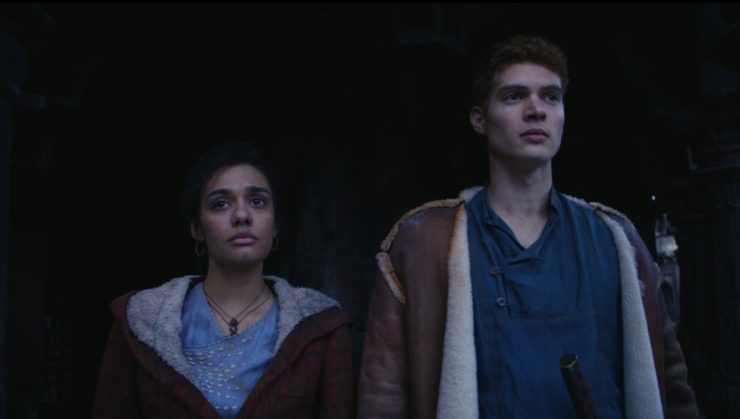
- We have confirmation that Egwene’s horse is named Bela! Bela is the Bill the Pony of The Wheel of Time and makes many appearances in many books, owned at different times by different important characters. Probably she won’t show up again in the show (though maybe she will!), but it was a fun moment for book fans.
- Favorite quote of the episode: “You’re not the type of woman who hears ‘no’ often, are you?”/ “I am not.”
- Runner up: “You don’t listen to the wind, Egwene. It’s the wind that listens to you.”
Join me back here tomorrow for my review of episode three: “A Place of Safety.”
Sylas K Barrett is a writer, actor, and long-time fan of epic journeys, heroes, and magic. You can find other reviews and op-eds here on Tor.com, including his ongoing Reading the Wheel of Time series, in which he reads the novels for the first time and engages in both critical analogy and a fair bit of fanboy glee.










